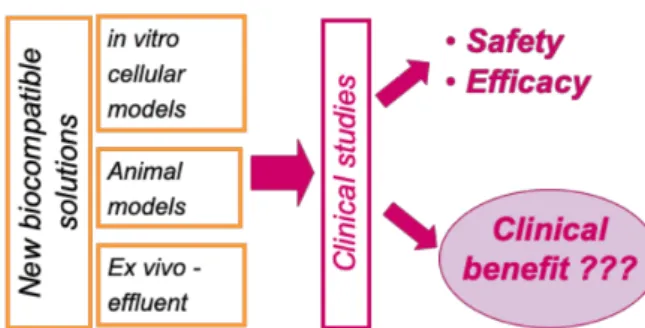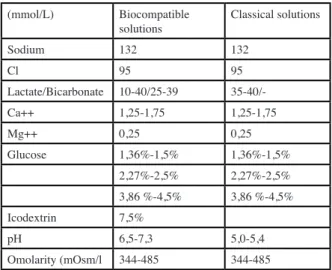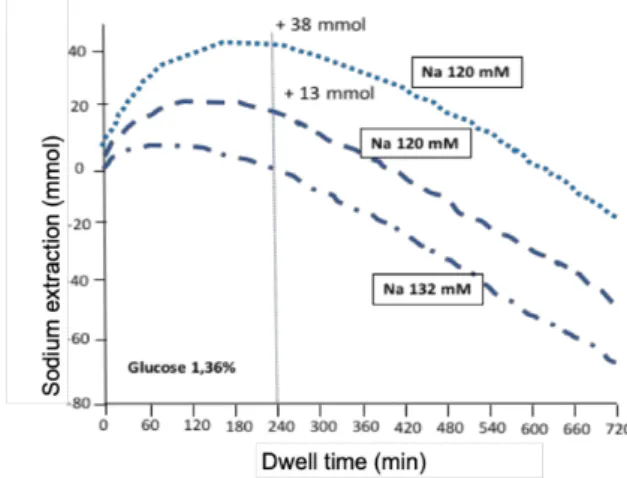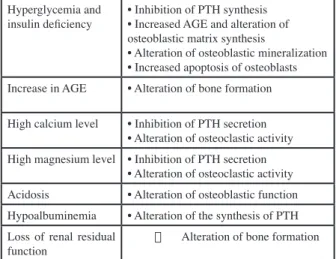NEW PERITONEAL DIALYSIS SOLUTION, FOR WHICH BENEFITS ?
(Nouveaux dialysats péritonéaux, pour quels bénéfices ?)
François Vrtovsnik1
1Service de Néphrologie, Hôpital Bichat, AP-HP, Université Paris Diderot, Paris
Résumé
Une solution de dialyse idéale réalise des échanges permettant l’équilibre du bilan hydro-électrolytique et l’épuration des déchets du métabolisme au moindre risque d’effets secondaires pour l’individu et la membrane péritonéale. La reconnaissance du rôle toxique des produits de dégradation du glucose (GDP) générés par les processus de fabrication a conduit à l’avènement des solutions dites biocompatibles à faible contenu en GDP et dont le tampon n’est plus exclusivement le lactate mais un système lactate/bicarbonate ; le bénéfice expérimental bien établi de ces solutions a une traduction plus nuancée dans les cohortes cliniques. On retient qu’elles permettent une meilleure préservation de la fonction rénale et de la diurèse. Le glucose reste l’agent osmotique principal ; le rôle délétère des solutions hypertoniques de glucose est reconnu et le recours à ces solutions doit être le plus limité. Les concentrations de sodium, calcium et magnésium dans le dialysat, proches des valeurs plasmatiques, rendent compte d’un transport diffusif limité et d’une extraction dépendante du volume d’ultrafiltration. Le recours à des solutions dont la concentration de calcium est supérieure à 1,25 mmol/l génère une charge calcique qui concourt au risque élevé d’ostéopathie adynamique et doit être évité. Le bénéfice expérimental de l’augmentation de l’extraction sodée par les solutions à faible concentration de sodium doit être confirmé.
Le
B
ulletin de la
D
ialyse à
D
omicile
Mots clés : solutions de dialyse, péritonéale, dialysate,
journal officiel du Registr e de D ialyse Péritonéale de Langue Française RDPLF www .rdplf.or g Abstract
The ideal peritoneal dialysis solution should allow efficient withdrawal of waste products of the metabolism and water and solutes equilibrium with minimal side effects for the patient and the peritoneal membrane. Glucose degradation products (GDP) resulting from the manufacturing process play a major toxic role and new biocompatible PD solutions with low GDP content and a more physiological bicarbonate or bicarbonate/lactate buffer have brought a clear benefit in experimental studies; however, in clinical cohorts and meta-analysis, the benefits of these solutions appear limited to better preservation of residual renal function and of diuresis. Glucose is the principal osmotic agent although hypertonic glucose solutions have a deleterious effect on PD, and their use should be restrained. Dialysate concentrations of sodium, calcium and magnesium are close to plasma; their diffusive transport is thus limited and their net peritoneal transport mainly depends on the ultrafiltration volume. A dialysate calcium concentration above 1.25 mmol/l generates a calcium load which may contribute to the high prevalence of adynamic bone disease in PD patients; this should be avoided. Low sodium dialysis solutions experimentally improve sodium diffusive transport and extraction in PD patients; the clinical benefit of this approach has to be confirmed.
Keywords : dialysis solutions, dialysate, peritoneal
NEW DIALYSIS SOLUTION... WHY ?
Loss of ultrafiltration and under-dialysis reflect de-creased effectiveness of peritoneal dialysis (PD); they are associated with an increase in morbidity and mor-tality and are responsible for nearly 40% of tech-nical drop-outs and transfers to hemodialysis (1). Loss of exchange efficiency is underpinned by mor-phological abnormalities and functional alterations of the peritoneum (2). Peritoneal membrane pathophy-siology is not univocal, involving in particular cumu-lative exposure to dialysis solutions and their bio-in-compatibility components as well as the occurrence and repetition of episodes of peritoneal infections (3). Among bio-incompatible agents, numerous studies have pointed at the involvement of glucose degradation pro-ducts (GDP) formed during the PD solution manufac-turing process (4). In vitro, in cultured peritoneal cells as well as in vivo in animals, exposure to GDP leads to the formation and deposition of advanced glyca-tion end-products (AGEs) and the inducglyca-tion of various inflammatory cytokines and angiogenic and pro-fibrotic factors. In experimental animal models, inhi-bition or activation of the signaling pathways triggered by these AGEs prevents or reproduces the morpholo-gical lesions and functional alterations observed in PD patients. Other factors involved in PD solution bio-in-compatibility include: the use of lactate buffer and the acid pH of the solutions (pH 5.5), some plasticizers used in the composition of the bags, the high osmolarity of the solutions, and even the glucose itself (Figure 1).
These observations led the pharmaceutical industry to develop new solutions with a reduced GDP content and/ or a pH closer to physiological pH by replacing the lac-tate buffer with bicarbonate or laclac-tate / bicarbonate to
buffer the solutions (Figure 2). In vitro, these solutions were significantly less toxic effect to peritoneal cells and tissues. In vivo, clinical studies in humans have rapidly shown the expected benefits (5) (Figure 3). The composi-tion of biocompatible vs classical PD solucomposi-tions is shown in Table 1. The most commonly used osmotic agent is
glucose. Three ranges of concentrations are available depending on the ultrafiltration needs of patients: «low» or «isotonic» glucose solutions, containing 1.36 to 1.5% glucose depending on the manufacturers, «intermediate solution» containing 2.27 to 2.5% glucose, and high «hypertonic» solutions containing 3.86 to 4.5% glucose. Calcium concentration is the other selection criterion for a given osmolarity solution.
ANALYSIS OF NEUTRAL PH AND LOW GDP CONTENT SOLUTIONS
In 2014, the Cochrane Group produced a meta-analysis of available clinical trial data (6). Although the publications are numerous, the authors of this meta-analysis comment on the suboptimal nature of many of
journal officiel du Registr e de D ialyse Péritonéale de Langue Française RDPLF www .rdplf.or g
Fig. 1 : General Pathophysiology
Fig. 2 : Content of glucose degradation products of biocom-patible (A to D) and conventional solutions.
3-DG, 3-deoxyglucosone; 3,4-DGE, 3,4-dideoxygluco-sone-3-ene; 5-HMF, 5-hydroxymethyl furaldehyde; AcA, acetaldehyde; FoA, formaldehyde (from ref 4)
the studies: low numbers of included patients, clinical an treatment heterogeneity between patients, incomplete or missing data, loss of participants during follow-up. The bibliographic search found 540 studies of which 18 were retained in the analysis, gathering 1351 patients. - There is no significant effect of biocompatible solutions on infusion pain (p = 0.08), occurrence of peritoneal infections, technical survival or patient survival. - Urine output and residual renal function are higher in patients treated for more than 12 months with «biocompatible» solutions. The calculated benefit is 0.7 ml / min / 1.73m2 in patients treated 12 to 24 months; this benefit is not significant in patients treated for less than 12 months. The mechanism of preservation of diuresis and residual renal function is unclear but may involve relative hypervolemia associated with increased peritoneal transport observed in patients exposed to biocompatible solutions.
- There is no increased risk or side effects associated with the use of bio-compatible solutions The recent publication by Schaefer (7) reinforces these observations; histo-morphometric and molecular analysis of systematic peritoneal biopsies performed in 196 PD patients, all treated with biocompatible solutions, evidenced the early development, within the first 6 months of treatment, of alterations indicative of local inflammation , epithelial-to--mesenchymal transition and peritoneal hypervascularization, all changes associated with peritoneal transport alterations. The Global Fluid Study is a multicenter prospective observational study that included 960 PD-treated
patients, of which 295 were treated with conventional solutions only and 71 with biocompatible solutions only (8). Analysis of these 366 patients indicates an early and continuous increase in transport parameters in patients receiving conventional solutions, while in the «biocompatible solutions» group, transport parameters stabilize after 2 years without further increase. In addition, the increase in transport parameters observed in the aftermath of a peritoneal infection in the «conventional solutions» group is not observed in the «biocompatible solutions» group. These results support two important conclusions: (i) glucose itself, in addition to its degradation products, could have a specific toxic effect, ; (ii) the benefit of biocompatible solutions is manifest in the longer term. THE CHOICE OF THE OSMOTIC AGENT
Glucose is the main osmotic agent used in the composition of PD solutions. The use of these solutions leads to a daily absorption in the order of 50 to 150 grams of glucose, which is associated with increased atherogenic and cardiovascular risk in patients already highly prone to these conditions. The deleterious effect of peritoneal exposure to solutions with high glucose concentration is well documented; in contrast, restricting the use of hypertonic glucose solutions protects against the worsening of small molecule transport rates (9). Exposure to solutions with high glucose concentrations does not only affect the peritoneal membrane but also has deleterious systemic effects related to poor glycemic control and metabolic complications, and ultimately leads to a higher risk of technical failure and mortality. The EDEN and IMPENDIA studies evaluated the effect of glucose reduction protocols based on the use of icodextrin and amino acid solutions. Although an improvement in HbA1c and triglycerides was observed in the low-glucose group, no improvement in cardiac function parameters or quality of life was seen. In addition, a possible increase in the risk of water-overload was suggested in the low-glucose group (10). Maintaining a total daily ultrafiltration (diuresis + peritoneal UF) greater than 1 liter / day is a major objective of adequate dialysis. Ultrafiltration obtained with crystalloid solutions (glucose) relies on peritoneal aquaporins. The functionality of aquaporins can be evaluated in clinical practice by measuring the dialysate sodium concentration at an early time during the exchange, when the osmotic gradient is maximal and produces a fast free-water flow by aquaporin-1 widely
journal officiel du Registr e de D ialyse Péritonéale de Langue Française RDPLF www .rdplf.or g
Tableau I. Composition of peritoneal dialysis solutions (mmol/L) Biocompatible
solutions Classical solutions
Sodium 132 132 Cl 95 95 Lactate/Bicarbonate 10-40/25-39 35-40/-Ca++ 1,25-1,75 1,25-1,75 Mg++ 0,25 0,25 Glucose 1,36%-1,5% 1,36%-1,5% 2,27%-2,5% 2,27%-2,5% 3,86 %-4,5% 3,86 %-4,5% Icodextrin 7,5% pH 6,5-7,3 5,0-5,4 Omolarity (mOsm/l 344-485 344-485
expressed in peritoneal cells (dip» or «sodium-sieving» measurement) while sodium transfer is slower (11). The loss of the aquaporin function is the cause of a loss of ultrafiltration documented in 35 to 40% of cases. In this case, the maintenance of ultrafiltration requires the use of colloid osmosis, independent of aquaporins, and based on the use of icodextrin solutions, which is glucose polymer.
The Cochrane meta-analysis confirmed the benefit of icodextrin in maintaining daily ultrafiltration and reducing episodes of water-overload. No significant effect were observed on residual renal function, diuresis, peritoneal clearance of creatinine, risk of peritoneal infection, occurrence of side effects, technical survival or patient survival.
DIALYSATE SODIUM CONCENTRATION Equilibrium of the sodium balance is one of the goals of adequate dialysis. Sodium extraction is ensured by residual diuresis and peritoneal extraction; the latter mostly dependent on the ultrafiltration flow. Indeed, since sodium concentration in the PD solution is set at 132 mmol / l, the sodium concentration gradient between the dialysate and the plasma is typically low, which limits sodium diffusion.
Experimentally, in humans or animals, and as predicted by mathematical models of peritoneal exchange, reduction of sodium in the PD solution makes it possible to significantly increase sodium extraction by diffusion (12) (Figure 4). ). However, the osmolarity of the solutions decreases in proportion of sodium reduction and the ultrafiltration volume generated by the exchange decreases. Partial compensation of the osmolarity of the solution therefore becomes necessary requiring an increase in glucose concentration . On the other hand, isolated sodium extraction bears a theoretical risk of hyponatremia. Short-term clinical trials evaluated the effect of low (115-125 mmol / l sodium) and very low (102 mmol / l) sodium solutions and found that these solutions lead to reduced loss of free water, diminished thirst and increased peritoneal sodium extraction by 35 to 55% as compared to conventional solutions. Some studies also observed an improvement in blood pressure control, which remains to be confirmed (13,14).
CALCIUM AND
MAGNESIUM CONCENTRATION
Calcium and magnesium concentrations in dialysis solutions are close to the physiological plasma
concentrations. The diffusion gradients are low and the peritoneal extraction of these ions depends essentially on the volume of ultrafiltration.
For a dialysis solution containing 1.25 mM of calcium, the daily dialysis extraction is in the order of 1 to 1.5 mmol, which is close to the average value of the daily urinary elimination of calcium. This value varies with the type of solution: close to zero for an isotonic exchange, and 0.8 mmol for a hypertonic exchange 3.86%, or about 0.12 mmol of calcium per 100 ml of ultrafiltration. Regarding magnesium, a concentration in the solution of 0.25 mmol / l leads to a peritoneal extraction of the order of 0.5 to 1 mmol / l, a value also close to the daily urinary elimination. The renal osteodystrophy of the patient on PD is marked by a very high prevalence of adynamic osteopathy (nearly 50%) (Table II) (15). Prevention of this complication requires avoiding the use of dialysis solutions with a high concentration of calcium (> 1.25 mmol / l), and limiting oral calcium intake to less than 1.5 g / day of calcium -element.
BUFFER CHOICE : LACTATE OR BICARBONATE
The development of multi-compartment bags has made it possible to prepare solutions using bicarbonate as a buffer system without the risk of precipitating
journal officiel du Registr e de D ialyse Péritonéale de Langue Française RDPLF www .rdplf.or g
Fig. 4 : Modeling of sodium extraction as a function of the exchange time (in minutes) according to the sodium concen-tration of the dialysis-sodium solution. Modeling sodium removal with a solution whose sodium concentration is 132 mmol / l, 120 mmol / l, and 102 mmol / l and the glucose concentration is 1.36% or adjusted.
Sodium extraction increases by 13 mmol and 38 mmol for dialysate sodium concentrations at 120 and 102 mmol / l. From Ref 11)
calcium carbonate or magnesium, and at a pH close to physiological values. Bicarbonate equilibrates to a CO 2 value determined by the Henderson-Hasselbach equation, ie 40 mmHg of PCO2 at a concentration of 25 mmol / L. For a dialysis solution exclusively buffered with bicarbonates, and at a higher concentration allowing an intake of alkalis, the resulting PCO 2 rises and is likely to create intracellular acidosis which in turn is likely to cause a loss of ultrafiltration due to a direct vasodilator effect and capillary recruitment. Notably, equivalent control of acidosis is achieved in children treated with APD with biocompatible dialysis solutions
with lactate or lactate / bicarbonate buffer (16).
CONCLUSION
In short, the use of hypertonic glucose solutions should be maintained to a minimum. Calcium concentration in the PD solutions should not exceed 1.25 mmol / l to reduce the risk of adynamic osteopathy. In case of abundant ultrafiltration, it may be necessary to increase oral calcium intake to avoid a negative calcium balance. The experimental and theoretical benefits of increasing sodium extraction with low sodium solutions needs to be confirmed.
Ten to 15 years after their introduction, experimental evidence of the benefits of PD solutions with neutral-pH and low-glucose degradation products on peritoneal alterations secondary to the technique has not been accompanied by the demonstration of major benefits in clinical cohorts. However, it can be concluded that these biocompatible solutions allow for better preservation of residual renal function and diuresis.
CONFLICTS OF INTEREST
the authors declare that they have no conflict of interest in this article.
BIBLIOGRAPHY
1. http://www.rdplf.org/sorties/887-sorties-2016.
html
2. Zhou Q. Preventing peritoneal membrane fi-brosis in peritoneal dialysis patients. Kidney International (2016) 90, 515–524
3. Pletinck A. Protecting the peritoneal mem-brane: factors beyond peritoneal dialysis solu-tions Nat. Rev. Nephrol. 8, 542–550 (2012) 4. Kawanishi K. Neutral solution low in glucose
degradation products is associated with less peritoneal fibrosis and vascular sclerosis in pa-tients receiving peritoneal dialysis. Perit Dial Int. 2013 May-Jun;33(3):242-51.
5. Perl J, Nessim SJ, Bargman JM. Kidney Int (2011) 79, 814–824; The biocompatibility of neutral pH, low-GDP peritoneal dialysis solu-tions: benefit at bench, bedside, or both?
6. Cho Y. Biocompatible dialysis fluids for perito-neal dialysis. Cochrane Database of Systematic Reviews
7. Schaefer B Neutral pH and low–glucose deg-radation product dialysis fluids induce major early alterations of the peritoneal membrane in children on peritoneal dialysis. Kidney Interna-tional (2018) 94, 419–429
8. Elphick E. Biocompatible Solutions and Long-Term Changes in Peritoneal Solute Transport. Clin J Am Soc Nephrol. 2018 Oct 8;13(10):1526-1533
9. Pagniez D. No increase in small-solute trans-port in peritoneal dialysis patients treated with-out hypertonic glucose for fifty-four months. BMC Nephrology (2017) 18:278. DOI 10.1186/ s12882-017-0690-7 journal officiel du Registr e de D ialyse Péritonéale de Langue Française RDPLF www .rdplf.or g
Figure 5. Risques et bénéfices des solutions « bas-sodium »
Tableau II : Contributing factors to adynamic osteopathy in peritoneal dialysis.
Hyperglycemia and
insulin deficiency • Inhibition of PTH synthesis• Increased AGE and alteration of osteoblastic matrix synthesis
• Alteration of osteoblastic mineralization • Increased apoptosis of osteoblasts Increase in AGE • Alteration of bone formation High calcium level • Inhibition of PTH secretion
• Alteration of osteoclastic activity High magnesium level • Inhibition of PTH secretion
• Alteration of osteoclastic activity Acidosis • Alteration of osteoblastic function Hypoalbuminemia • Alteration of the synthesis of PTH Loss of renal residual
10. Li PKT. Randomized, Controlled Trial of Glu-cose-Sparing Peritoneal Dialysis in Diabetic Patients. J Am Soc Nephrol 24: 1889–1900, 2013
11. Rippe B, Venturoli D, Simonsen O, de Artea-ga J. Fluid and electrolyte transport across the peritoneal membrane during CAPD according to the three-pore model. Perit Dial Int 2004; 24:10–27.
12. Wang T. A quantitative analysis of sodium transport and removal during peritoneal dialy-sis. Kidney Int. 1997 Dec;52(6):1609-16. 13. Davies S. The effects of low-sodium
peritone-al diperitone-alysis fluids on blood pressure, thirst and volume status. Nephrol Dial Transplant (2009) 24: 1609–1617
14. Rutkowski B. Low-Sodium Versus Stan-dard-Sodium Peritoneal Dialysis Solution in Hypertensive Patients: A Randomized Controlled Trial. Am J Kidney Dis. 2016 May;67(5):753-61
15. Levy R. Renal osteodystrophy in peritoneal dialysis: special considerations. Perit Dial Int 2008; 28(S2):S11–S19.
16. Schmitt CP. Effect of the Dialysis Fluid Buffer on Peritoneal Membrane Function in Children. Clin J Am Soc Nephrol 8: 108–115, 2013
Receives 2018/12/20, accpeted after revision 2018/12/22 published 2018/12/30 journal officiel du Registr e de D ialyse Péritonéale de Langue Française RDPLF www .rdplf.or g
Open Access This article is licensed under a Creative Commons Attribution 4.0 International License, which permits use, sharing, adaptation, distribution and reproduction in any medium or
format, as long as you give appropriate credit to the original author(s) and the source, provide a link to the Creative Commons license, and indicate if changes were made. The images or other third party material in this
article are included in the article’s Creative Commons license, unless indicated otherwise in a credit line to the material. If material is not included in the article’s Creative Commons license and your intended use is not permitted by statutory regulation or exceeds the permitted use, you will need to obtain permission directly from the



